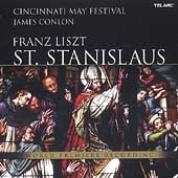|
You are reading the older HTML site
Positive Feedback ISSUE
15
Franz Liszt,
St. Stanislaus, Cincinnati Symphony Orchestra, May Festival Chorus, James
Conlon, conductor (Telarc CD 80607)
First we had the Unfinished Symphony by Franz Schubert, now we have what I have dubbed the "Unfinished Oratorio," the last composition by Franz Liszt. This is something not seen or heard every day, or even every year—once per century is more accurate. There is virtually nothing about this composition to be found in musical textbooks. Liszt’s biographer refers to it, but the piece was never finished or performed. Only fragments of the score exist, and most of the fragments disappeared soon after Liszt’s death in 1886. Paul Munson, the Liszt scholar and musicologist, eventually found many of them. The oratorio was to have four scenes, but it seems that only the first and last, plus an aria scored for piano and soprano, were finished. Almost everything known about this work has come by way of Paul Munson. Not only did he orchestrate the aforementioned aria in a Lisztian manner, he wrote the liner notes for this premiere recording, as well as the text and translation. Schubert failed to complete his Unfinished Symphony because he did not have a satisfying ending in mind. Liszt, on the other hand, knew how St. Stanislaus should end. Could he have spent all that time trying to compose the two middle scenes, before finally giving up on them? My opinion is that the finished scenes can stand on their own, either separately or together. Liszt could have used the phrase that he had supposedly coined years earlier—"tone poem"—to classify them. During the Romantic period, there were three large-scale genres of choral music—the mass, the requiem mass, and the oratorio. Oratorios were expected to feature a great deal of choral music. This contributed to their growing popularity, as people without a great deal of musical training were able to perform in the choruses. As time went on, oratorios moved out of church settings and onto public stages. Religious themes were often replaced by secular pieces in a variety of styles and moods, and often by shorter, more lyrical works. St. Stanislaus is about the martyrdom of Poland’s patron saint, eight hundred years earlier. Obviously religious in scope, the text makes it clear that it is also about "the eternal conflict between the Church and the State and that no priest is above the law and no magistrate is beyond needing spiritual counsel and admonishment." This sounds like stories we continue to hear on the evening news—some things never change. The first scene has an instrumental introduction lasting almost seven and a half minutes. Using the melody of a chant minus the voices, it sets a somber and reflective mood. It is largely built upon the lower registers of the string section—cellos, double basses, violas, and second violins. Near the end of the introduction, the first violins and horns appear, completing the orchestration. The depth of the soundscape is not as pronounced as usual, probably because the chorus is seated to the rear of the orchestra. In the almost dozen minutes following the orchestral introduction, the setting is mainly that of a fairly distant crowd scene, and there are short songs by various soloists and the chorus. There is no prominence given to the vocal sections, and the orchestra really comes to life in a couple of forte passages. This changes with the aria, the only existing portion of the score from scenes two or three. Mezzo-soprano Kristine Jepson is highlighted here, and she responds splendidly, with a refreshing lack of excessive vibrato. Though scored by Paul Munson, the excellent orchestral backing is appropriately Liszt-like. This is not a typical oratorio, as half of it does not exist. If the aria were not included, this recording would contain almost as much orchestral music as vocal. Following the delightful aria are two orchestral interludes that begin the fourth and final scene, and that signify a definite change. The brass and winds are featured more heavily than in the first scene. There is a feeling of joy or celebration, helped by the fine music making and sympathetic response of the Cincinnati Symphony Orchestra. The last two sections of the final scene feature baritone Donnie Ray Albert. In the Psalm 129, a setting with the repentant King and monks, he is accompanied by a male chorus. The final section features the entire May Festival Chorus, an integral part of Cincinnati’s annual May Festival. The final words of the oratorio (when translated) ring out as "Hail Poland!" This "newly found" old composition, now available for listening for the first time, must be recommended to those who enjoy Romantic period vocal music and to oratorio aficionados. Anyone who likes Liszt’s music will find it a must-own selection, as will all those open-minded enough to search out the new—or, in this instance, the oldest of the new. Lovers of orchestral music may find the vocal and choral sections to be interesting interludes. The sound quality of this recording is very good, though it is not outstanding. I would have preferred more vocal presence, although in the last scene, the soloists are more clearly heard than in the first. The chorus should be almost overwhelming, but this CD has an almost mid-hall perspective, with the chorus to the rear of the orchestra. All is smooth and sweet, though not quite as detailed as some Telarc recordings. Continued listening has increased my appreciation of this recording. Each scene stands on its own quite well, although when performed together, they do not quite form a fully satisfying entity. Karl Lozier
|

